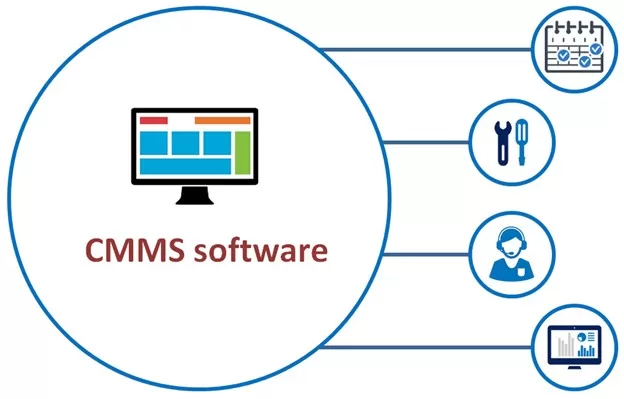In the fast-paced world of building management, efficiency, cost-effectiveness, and streamlined operations are paramount. To achieve these goals, many organizations are turning to Computerized Maintenance Management System (CMMS) software. CMMS software offers a comprehensive solution that revolutionizes the way large buildings are managed and maintained.

Gone are the days of manual maintenance tracking, scattered data, and reactive approaches. CMMS software brings a host of benefits, empowering facility managers to proactively manage assets, streamline maintenance operations, optimize resource allocation, enhance communication, ensure compliance, and much more.
In this blog, we will explore the numerous advantages that CMMS software offers for large building management.
A Computerized Maintenance Management System (CMMS) is a digital solution designed to streamline and optimize maintenance operations in various industries.
The goal of CMMS software is to effectively manage assets, streamline maintenance workflows, and improve overall operational efficiency. It serves as a centralized hub for managing maintenance activities, assets, work orders, and data related to building management.
There are many useful features of CMMS software that can make maintenance management easy. Here are some features of CMMS:
Large building management comes with its own set of unique challenges, from managing complex infrastructure to ensuring efficient maintenance operations. CMMS (Computerized Maintenance Management System) software offers a range of benefits specifically tailored to address these challenges.
CMMS software provides a centralized platform for creating, assigning, and tracking work orders. This eliminates manual paperwork, reduces the risk of miscommunication, and ensures that maintenance tasks are efficiently managed and completed on time.
Maintenance technicians can access work orders on their mobile devices, enabling real-time updates and smoother collaboration between team members.
Read Also:
One of the most significant benefits of CMMS software is its ability to schedule and automate preventive maintenance tasks. By implementing a proactive maintenance strategy, organizations can prevent unexpected equipment failures, reduce downtime, and extend the lifespan of assets.
It sends automated reminders for routine inspections and maintenance, ensuring that equipment is properly serviced and maximizing its operational efficiency. This way, workers won’t miss the scheduled maintenance that can delay their production.
This kind of digital transformation serves as a comprehensive database for managing assets in large buildings. It allows organizations to track assets, including equipment, facilities, and infrastructure, along with their maintenance history and documentation.
This centralized asset management system enables better planning and decision-making for repairs, replacements, and upgrades. By understanding the condition and performance of assets, facility managers can allocate resources effectively, optimize maintenance schedules, and minimize costs.
CMMS software includes inventory management capabilities, enabling organizations to track and manage spare parts and supplies. It helps maintain accurate inventory levels, ensures timely reordering, and prevents stockouts or excess inventory.
Efficient inventory management reduces maintenance downtime by ensuring that the necessary parts are readily available when needed, optimizing maintenance operations, and minimizing costs associated with inventory management.
This software enables real-time monitoring of maintenance activities, asset performance, and key performance indicators (KPIs). It provides dashboards and reports that offer insights into maintenance trends, equipment reliability, and resource utilization.
Facility managers can access up-to-date data, identify areas for improvement, and make data-driven decisions to enhance operational efficiency and reduce costs.
CMMS maintenance software helps organizations comply with safety regulations and industry standards. It allows for documentation of inspections, maintenance records, and safety checks, ensuring that all necessary protocols are followed.
This proactive approach to compliance minimizes the risk of accidents, improves occupant safety, and protects the organization from potential liabilities.
CMMS software facilitates communication and collaboration among various stakeholders involved in building management. It provides a platform for technicians, managers, and contractors to communicate, share updates, and address maintenance issues promptly.
This transparent and streamlined communication process enhances efficiency, minimizes response times, and improves overall collaboration within the maintenance team.
Through intelligent monitoring, organizations can achieve significant cost savings and improve their ROI. Proactive maintenance practices reduce the risk of costly equipment failures, minimize unplanned downtime, and extend the lifespan of assets.
Efficient resource allocation and inventory management prevent unnecessary expenses. Additionally, it helps organizations make data-driven decisions, optimize maintenance schedules, and reduce overall operating costs.
Choosing the right CMMS solution for your building management needs is crucial for streamlining maintenance operations and improving overall efficiency.
The following are some key factors to consider when selecting a CMMS solution:
Implementing CMMS software for large building management brings numerous benefits and efficiencies. By streamlining work order management, automating preventive maintenance, optimizing asset management, improving communication, and enhancing compliance, organizations can achieve greater operational efficiency, reduce costs, and ensure seamless building operations.
The best technical practices mentioned can ensure successful implementation and ongoing utilization of CMMS software, leading to improved maintenance practices and long-term sustainability. With CMMS software, large building management becomes more proactive, data-driven, and effective, resulting in improved occupant satisfaction and optimized resource utilization.